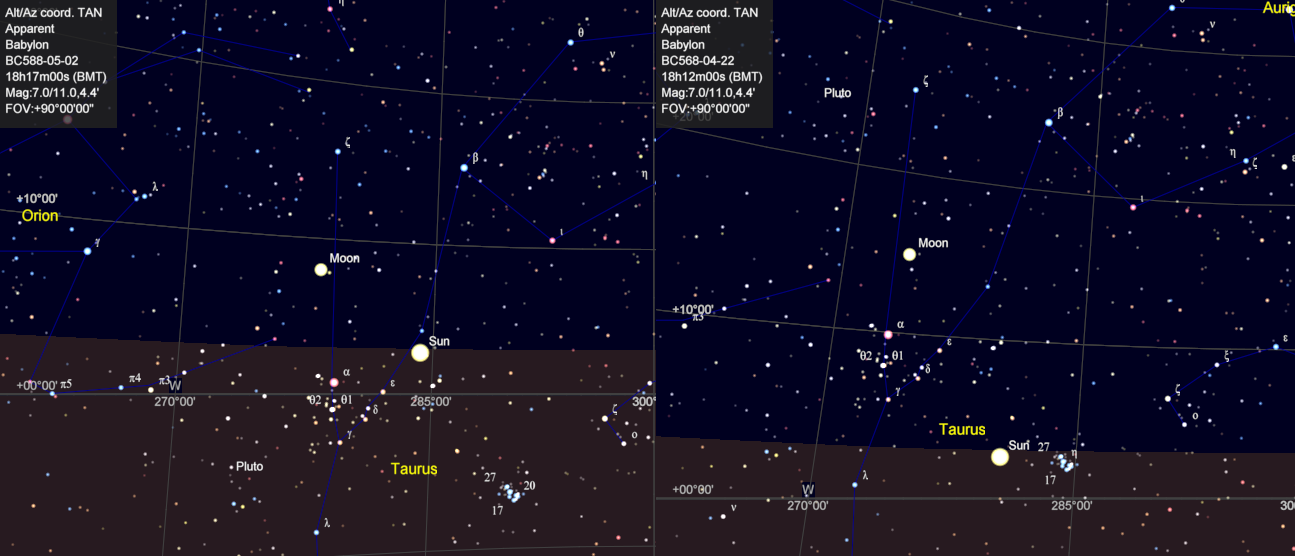Note
Can the Year start in May?
This is a common argument against VAT4956 being dated to the year 588 BC. See article Late Start
Note B
the moon became visible behind the Bull of Heaven
When the Moon is first visible it normally isn't that far behind the setting Sun. The stars would not be visible in the twilight sky. This position must be approximated based on what is visible once all the stars can be seen in the western sky, or by the experience of the observer.
"the moon became visible"
For more information read the article about New Moon Sightings
.Note C
Moon position 1
the moon became visible behind the Bull of Heaven

The Moon is behind (sets after it) Taurus in 588 BC, in either year the stars of Taurus would not have been visible by the time the Moon had set.
Critics say that the Babylonian year never started as late as May, please read Late Start for an explanation.
Another argument against the year 588 BC is that critics say they the moon would not have been visible on this day. Consider the article New Moon Sightings for a comparison to a new moon sighting in modern times.
Position 13 | Position 1 | Position 2
Note D
| Symbol | Syllables | Meanings |
|---|---|---|
 |
MU | MU |
  |
37 | thirty-seven |
 |
DIŠ | Constantly, always, one, sixty, if |
 |
AG | AG |
 |
ĝar niĝ2 ša2 |
Place Thing of |
 |
DU DE6 GUB TUM6 |
go bring stand, sheep |
 |
ŠEŠ | ŠEŠ |
 |
LUGAL | Jupiter; one of the Seven Twin Stars; α Centauri; α Leonis - P. Felix Gössman; Planetarium Babylonicum (1950) pg 89 šarru: king |
   |
TIN.TIRKI | Babylon |
 |
MAŠ BA7 BAR |
ḫuzālu: gazelle kid; ṣerru: snake, possible name for Hydra constellation; Māšu: twin, Gemini; bīru: goat half Nissan, first month - on VAT4956 there seems to be no distinction between BAR and MAŠ |
 |
ušu3 ba3 es2 sin |
šalāšā: thirty, 30 half the moon |
 |
ušu3 ba3 es2 sin |
šalāšā: thirty, 30 half the moon |
 |
UB | Translated as: behind; tubqu: a corner. |
  |
GU4.AN | only refers to "bull of heaven" on VAT4956. Not used on any other astronomical diary |
 |
IGI | naṭālu: (to be able) to see , to look at, to gaze ; to observe (the sky); to be visible; ina maḫar: before (someone), in the presence, in front of - The Assyrian Dictionary, Volume 10, M, Part I, (1977) pg 106 |
 |
U bur3 šu4 ge14 |
Earth, finger, ten, totality Unit Cover Blow and |
Note E
A. The moon observations.
1. On Nisan 1 the moon became visible behind the Hyades (Vs. 1).
New Moon —567 April 21 5h afternoon. The moon will be visible the following evening.
April 22, 7h evening:
- Moon λ = 40°.2 ß = -3°.8
- Hyades λ = 32°.2 ß = -6°.0
TRANSLATION FROM: Paul V. Neugebauer und Ernst F. Weidner (1915) Ein astronomischer Beobachtungstext aus dem 37. Jahre Nebukadnezars II (- 567/66).
Modern Results
New moon: -567 Apr 21 17:36 (+3) (astropixels.com )
SkyCharts:
- BC568-04-22 19h00m00s ( +03 )
- Moon = L: +39°26'48" (+39.44°) B:-03°57'24" (-3.95°)
- θ2 Tauri = L: +32°13'10" (+32.21°) B:-06°07'14" (-6.12°)
- ΔT 18208.16s ( 05h03m28.16s )
Rear Line 21 | Front Line 1 | Front Line 2
